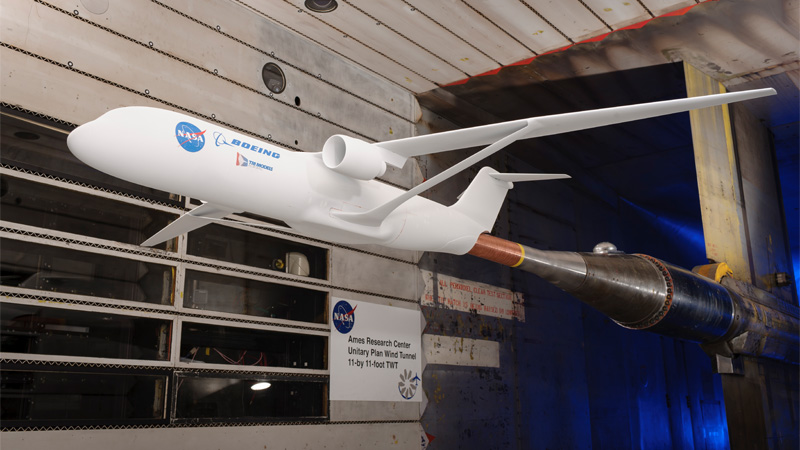Stay Up to Date
Submit your email address to receive the latest industry and Aerospace America news.
The Applied Aerodynamics Technical Committee emphasizes the development, application and evaluation of concepts and methods using theories, wind tunnel experiments and flight tests.
NASA’s Advanced Air Transport Technology Project and Boeing tested a 4.5-percent scale model of a Transonic Truss Braced Wing, TTBW, aircraft concept in the 11-Foot Transonic Wind Tunnel at NASA’s Ames Research Center in California. Force, moment and surface pressure data were obtained with the use of multiple optical measurement techniques. Model component build-up data and drag-rise data were obtained on both baseline strut and alternate strut configurations.
Control surface deflections were also investigated to support the assessment of stability and control characteristics. The TTBW configuration is expected to produce at least a 50 percent reduction in fuel burn and carbon emissions compared to current transport aircraft, and a 4 to 8 percent reduction compared to an equivalent conventional advanced technology configuration. Initial test analysis shows the TTBW as a promising technology for future energy efficient transports.
The Advanced Vertical Flight Laboratory at Texas A&M University designed, built and flight-tested a 62-gram hummingbird-inspired flapping wing micro air vehicle, or MAV, with hovering capability. The robotic MAV was developed as a part of DARPA’s Nano Hummingbird initiative. The MAV was developed specifically for the purpose of scientifically investigating the flight dynamics, aerodynamics, and control of an actual flying vehicle utilizing flapping-based aerial locomotion. Additionally, Texas A&M tested the world’s smallest cyclocopter. A cyclocopter, unlike traditional helicopters, deploys a rotor with horizontal axis of rotation, allowing complete 360 degree thrust vectoring capabilities.
The Naval Surface Warfare Center’s Carderock Division investigated the aerodynamic hover performance of a series of generic Fan-in-Wing, or FIW, configurations in their 8-foot by 10-foot Subsonic Wind Tunnel. The model was designed to allow the fan performance and overall FIW system performance to be measured independently. Researchers at the center are now preparing to test the FIW configurations in forward flight.
The Defense Department’s CREATE program, short for Computational Research and Engineering Acquisition Tools and Environments program continued developing and deploying scalable, multidisciplinary, physics-based computational engineering products for the design and analysis of ships, air vehicles and RF antennas. CREATE is part of the High Performance Computing Modernization Program. The Air Vehicles program, HPCMP CREATE-AV, released three products in 2016: the fixed-wing analysis tool Kestrel7.0, the rotorcraft analysis tool Helios7.0, and the conceptual-design tool DaVinci4.0. Kestrel7.0 introduces full-engine integrated aircraft simulation capability and Helios7.0 introduces integration of Kestrel core solver kCFD and NASA’s FUN3D, engine models and automated strand-based body mesh/solution for solving rotorcraft simulation problems. DaVinci4.0 enables rapid generation of parametric aircraft designs, including the ability to generate computer-aided-design outer-mold-lines and basic internal structures. ★
Stay Up to Date
Submit your email address to receive the latest industry and Aerospace America news.




